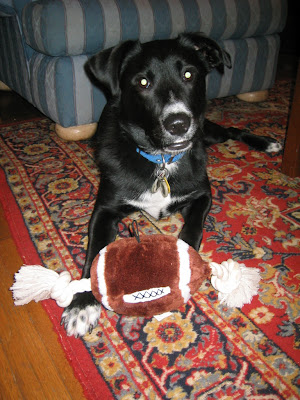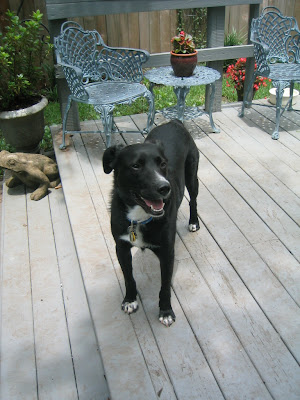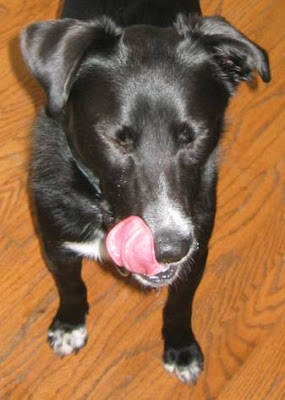
It’s true. Haskell broke his tail.
Well, I guess his tail really isn’t broken-broken. Just paralyzed-broken. He can’t move it at all. Not even a little bit. It’s pretty pathetic.
I first noticed the problem on Sunday night. We had just returned from a weekend at the ranch, and I was getting ready for bed. All of a sudden, I heard this panicked squeaking coming from the living room. Concerned, I immediately went to the source, where I found Haskell chewing frantically on his tail.
My initial thought was that there must be some sort of biting insect on him. So, I bent down and tried to find the culprit. However, Haskell was having none of it. I barely even touched his tail when Haskell let out a howl of pain. He’s normally quite the drama-king, but this sounded serious.
It was about that time that Haskell stood up, and I got my first good look at his tail. Normally, Haskell holds his tail straight up – prominently waving what Trevor and I refer to as his “white flag” (see picture below). Conversely, the tail I was looking at was, well, limp. Completely limp, actually. I almost mistook it for “scared” until I realized that his tail wasn’t tucked between his legs (classic sign for “I’m scared” in Dog). Instead, Haskell’s tail just…hung there. No wag, no nothing. Something was definitely amiss.

Tail = Normal

Tail = Not Normal
(he was walking forward in this picture, which is why his tail looks raised a bit)
(he was walking forward in this picture, which is why his tail looks raised a bit)
Again, I tried to touch his tail to feel for swelling, puncture wounds or something of that nature that would account for Haskell’s limp tail. However, he didn’t want me anywhere near it. Every time I tried to touch it, Haskell would squeak dramatically and spin around to face me – putting his whole little body between me and his ailing appendage.
So, not knowing what else to do, I decided to let him outside to "use the facilities”. I kept waiting to see Haskell’s tail return to its normal upright position, and was disappointed. I wasn’t overly concerned, however, until I watched Haskell try to…uhmmm…well, poo. The poor, little guy couldn’t move his tail out of the way! This especially bothered Haskell who tried to fix the problem by spinning in circles and biting at his tail – all from the classic pooing-dog-squat position. Under different circumstances, I’m sure I would have found the situation humorous.
Alarmed, I briefly considered rushing Haskell to the emergency vet. Then, I remembered that I still had one of his pain pills left over from his shoulder operation. So, I found some cheese in the fridge, rolled it into a ball and hid the pill inside of it.
Standard giving-of-treat procedures require my dogs to assume the “sit” position. So, it was no surprise for me to turn around and find Haskell trying to sit down. I say “trying to sit down” because he wasn’t successful. His tail kept getting in the way. Every time he attempted to sit, his tail would ram into the floor instead of wrapping around his body like normal. It was so painful to watch that I finally just gave the dog the cheese. I just couldn’t bear to watch anymore.
Anyway, after administering the cheese/pill ball, I put Haskell in his “box” (a.k.a. crate), before going to bed myself. It took awhile to get to sleep, however, because poor Haskell kept crying and squeaking from the other room. Finally, though, the pain pill started to work its magic and my little dog fell asleep.
The next morning I found myself hoping (against hope) that Haskell’s tail had repaired itself over night. However, this wasn’t the case. So, after getting dressed, I took Haskell and his broken tail to the doggie doctor.
The vet, after a very thorough examination of Haskell’s spine and tail, diagnosed the condition as "Swimmers Tail". That’s right: My dog that does NOT swim has a problem called SWIMMERS TAIL. This is like having Tennis Elbow and not playing tennis, in my opinion. Just my luck.
Apparently, Swimmers Tail is common in Labs (of which Haskell is presumably half), and occurs after a dog overexerts either himself or his tail. In the case of Haskell, it was probably both (we did spend the weekend at the ranch, after all). Anyway, what it comes down to is that my dog managed to temporarily paralyze his tail. A feat previously thought to be impossible (at least by me).
Hopefully, after several days of “box rest”, anti-inflammatory and anti-pain medication Haskell’s tail will return to its normal, upright, wiggly self.
Until then, though, I have a dog with a broken tail (who has proven once and for all that it IS possible to have too much of a good time). How ever did I get SO lucky?!

See?! No tail! How tragic!

Stupid Tail!
5 comments:
Aww, poor Haskell! I hope he heals up soon. Every dog needs to be able to wag his tail!
Poor little Haskell! It's just one thing after another with him.
Thanks for sharing your tale (no pun intended!)- it- especially the photos- helped me to diagnose Swimmer's Tail in my own active labrador pup!
Same thing happened to our dog this weekend, only she was actually swimming. Your post helped us diagnose our poor pup's condition. We thought we were helping her have a nice 4th of July weekend, and we feel terrible that she has a limp and painful tail from all that fun in the sun.
I'm so happy that Haskell's problem is able to help other canines in need! And their tails!
He generally "breaks" his tail once a year or so. It happens most frequently in the summer when he is most active. Nothing like having too much of a good time!
At least I now know what is happening, so it isn't nearly as alarming. And after a few days of napping and low activity, Haskell’s tail rises again!
Post a Comment